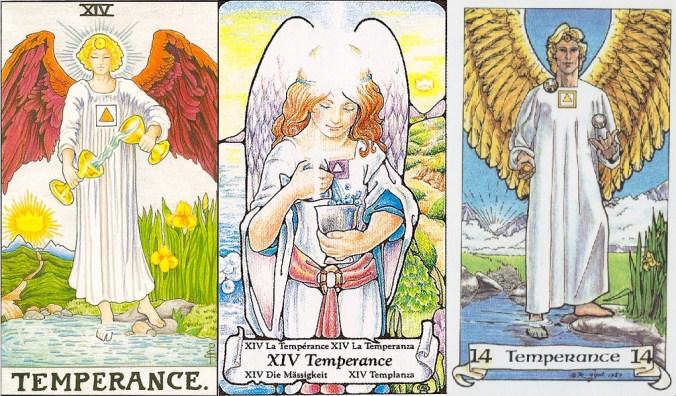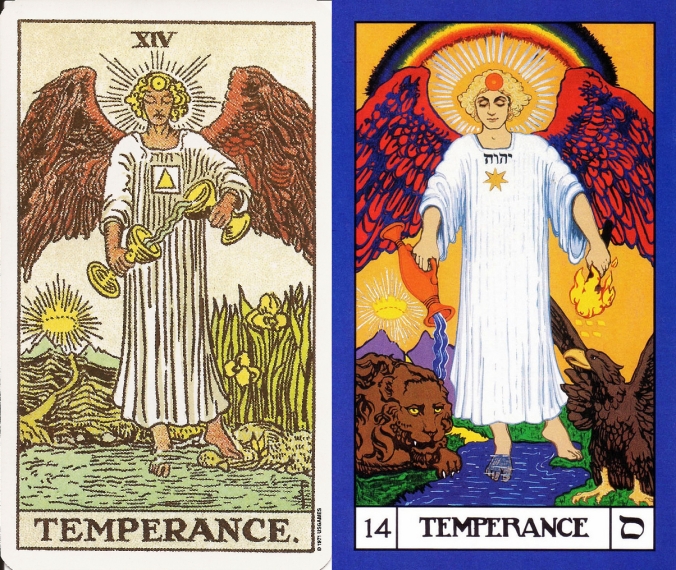After a line of cards with so many changes between decks, it’s nice to have a break with a card Robin Wood changed little from Waite’s. In fact, the only main differences I can see are that her angel is more clearly male, his wings are gold, he juggles balls instead of pours water between cups, the path behind him is less defined, and the sun is a white ball instead of a gold crown. All in all, not too bad.
I suppose it is best to begin with the figure of the angel. I think it best to consider him as a symbol of an intermediary between humanity and the heavens–however you conceive of that realm. Having undergone a death, the Fool now becomes an intermediary between his former earthly self and the celestial realm beyond the cycle of life. A similar way to view the angel is as the goddess Iris, an easy leap to make here given how most representations show the angel next to her flower. In fact, the B.O.T.A. (Builders of the Adytum) deck removes the flowers and arcs a rainbow–Iris’s primary symbol–over the angel’s head, as shown below. Iris was a messenger of the Gods in the Greek pantheon, and so represents their link with humanity. The depiction of this particular angel also reinforces the link between human and divine. His wings, for example, are the dark red of blood and so here refer back to a body. His robe, on the other hand, is purity’s white, and that all important sign of divinity.
Upon the angel’s breast are two symbols that bring a psychological link to the angel. The square and the triangle, in Waite’s terminology, stand for the septenary. This is a reference to a Theosophical concept known more colloquially as the sevenfold nature of man. The human being consists of seven principles, which are divided into a higher triad (the triangle) consisting of the divine, spiritual, and intellectual parts and a lower quaternary (the square) consisting of the passional, vital, astral, and physical parts. In this concept, the triad parts last forever while the quaternary parts last for only one life and are brand new in each individual’s discrete lifetime. In Theosophy, the triangle is typically seen above the square. By placing the triangle within the square, Waite is essentially demonstrating that “after the Ego’s death, eternal energies work within the square of ordinary activities and that we need not look to miracles to sense our connection with the immortal universe” as Rachel Pollack explains.
To reinforce this cooperation of divine and mundane in the new, reborn self, Waite has carefully included the tetragrammaton just above this symbol. This is hard to make out in the coloring of the above image, but is much easier to see in the one below where the Hebrew letters י ה ו ה are worked into the robe’s folds. (The B.O.T.A. card makes the tetragrammaton more obvious.) We last saw the tetragrammaton upon the Wheel of Fortune where it was an external mystery of fate, as Rachel Pollack notes. Here, however, it has become a very part of the Fool’s nature and, together with the septenary, shows how the Fool has become a master of his own fate.
The angel also wears the sign of the sun upon his forehead. This is a sign of higher consciousness, and it also marks the angel as the rising sun shown behind the towers of the Death card, which could potentially make the water he stands in the start of the river in Death. Behind the angel is a setting sun that conceals a crown. This crown represents the ego that died in the Death card, and the physical ream of the ego is further noted by transforming the two towers that made the gateway to the beyond in Death into two physical mountains.
The angel stands with one foot in the water and one foot upon land, which–like the septenary sign–illustrates how temperance blends energies, for as Pollack notes “the water symbolizes the emotions while the rock represents grounding ourselves in the ‘real world’ beyond our selves” and the angel does both at the same time. The angel also pours water from one cup to another, again symbolic of “all the elements of life flowing together.” Pollack also calls attention to the fact that the flow of the water here is a physical impossibility: pouring water runs down in a steep parabolic half: this shows a shallow diagonal path. Pollack notes that this may indicate that Temperance’s joyful ability to combine the elements of life would appear magical to those still trapped by ego’s masks.
For Waite, the type of Temperance he had in mind with this card was more along the lines of a type of self-control and equanimity, as evidenced by bringing together human and divine, unifying all the parts of man together with God’s essence, and blending all the energies together into a miraculous whole. For Robin Wood, however, the Temperance she most had in mind was the temperance of moderation. As she notes, “this card means economy, moderation, and patience. Perhaps the Seeker is going to achieve security by clever juggling of his resources. Perhaps she is going to go through a time where she has to juggle her resources! It may also mean meditation. Increasingly, to me, it means the ability to move gracefully and easily through life, not beset with uncontrolled appetites and avariciousness that can pull you off course. Everything in moderation (including moderation!).”Wood gave her angel golden wings instead of red to show the incorruptibility of the freedom, skillfulness, and mastery that wings are typically associated with. His white robe still means purity, but she notes his rolled-up sleeves indicate the angel is not adverse to hard work.
Like the Waite card, Wood’s angel wears a triangle within a square on his chest. She notes a similar symbolism: the square is the reality of the material world and the triangle is the spirit. Together, they symbolize the spirit in the flesh, which is life. The positions of his feet show that he is firmly grounded by in reality (the seen, consensual universe) and the unconscious (the instinctive, intuitive universe). The sun upon his head completes his mastery of elemental nature: he is free to move in air through his wings, water through one foot, earth through the other, and fire through the sun upon his brow.Instead of pouring water, Wood’s Temperance juggles three balls: a silver ball (spiritual wealth, the subconscious, and the present), a gold ball (material wealth, the conscious mind, and the past) and a crystal ball (mental aptitude, mystery, and the future). He handles them easily and controls all their forces within himself.The Irises next to him call to mind the Goddess Iris and her rainbow, and they serve as a reminder that temperance is beautiful and their yellow color signifies its joy. The mountains behind the angel lead to mountains of enlightenment, and the rocky path to them notes that finding enlightenment will not be easy, but will take you through a new vital course. The fog at the base of the mountains symbolizes the uncertainty of such a path, but also a reminder that with temperance, you can still stay on the path.
Wood also specifies that her sun is a rising sun, not a setting sun, and it shows the promise of the mastery that can be obtained if you follow Temperance’s path.
KEYWORDS: Inner balance, Mediation between human and divine, Combining different energies, Moderation, Calm.
Meditation
Close your eyes and imagine that you stand in a great, grassy field on a clear, sunny day. Hold in your mind a question about your life that stirs your emotions. Take several deep breaths and then look to the sky. From above comes a spiral of colored light. The complexities of light are too great to define, but this spiral swirls down around your body. As it does, it transforms you. It also transforms the question you hold in your mind. This swirl of light sweeps away all of your emotional ties to the situation at hand and leaves you with a clear mind. The spiral of light recedes to the heavens again. Now that your mind is clear, what is the best action for you to take in the situation–if any?Daily Practice
Keep the Temperance card with you or place it on your altar. For the duration of the day, attend to the small details of your life. The gods are in the details, so go find them there!
The card descriptions are a combination of my own insights and paraphrasing from a handful of sources. I’m currently working with Rachel Pollack’s books Seventy-Eight Degrees of Wisdom and The New Tarot Handbook, Robin Wood’s Robin Wood Tarot: The Book, and a smattering from Waite’s Pictorial Key. I also strongly recommend Joan Bunning’s book Learning the Tarot as well as the resources found on her website, learntarot.com.


